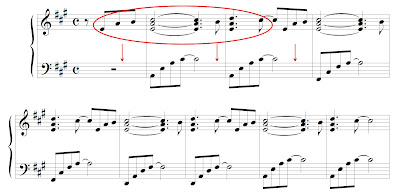[Post #16] In this post we will see some patterns that help to create and develop a melody with the right hand. Obviously, there are no secrets or fix rules because the melody often follows sounds, inspiration, taste, etc. These patterns can however help to understand how just an idea made of a few notes can become a nice song.
1) Melody repetition with bass chord changes
This is one of the most used techniques. The chord change gives the repeated notes a particular effect, it seems that the notes are new, even if replayed without any change.
The chord progression I use in this example is the one listed in this post of mine at the number 2.
The chord progression I use in this example is the one listed in this post of mine at the number 2.
The red ring highlights the melody repeated without any change, while the chord changes every 2 bars.
This is my recording at the piano of this pattern:
2) Octave change
All instrumental music uses this technique very often. The picture below shows the same melody as the previous pattern but one octave lower. Once again, repeating the melody changing octaves (and chords) gives a feeling of something new.
This is my recording at the piano of this pattern:
And this is a mix of the two previous patterns. I simply play the first two patterns one after the other. With these few notes and chords I have created a short song of about 1'30'':
3) Dividing the music space between the two hands
To explain this pattern I use the same picture of pattern 2. The arrows show that the right hand uses the free space left from the left hand. When the left hand does not play any note, the right one does, creating an interesting alternation between the two hands.
Listen to the previous recording and you will better understand what I mean:4) Time changes
As you can see from the two pictures below, the melody is the same but the first example is made of 1/8 notes and the second one of 1/16 notes. Between the first and the second example, there is another difference: the octave. This is another confirmation that all these patterns can be combined with each other.
In the following examples, I used the chord progression that you can find in this post of mine at number 26.
This is my recording at the piano of this example:In the following examples, I used the chord progression that you can find in this post of mine at number 26.
This is my recording at the piano of this example:
Finally a recording with these last two examples combined. Please note that:
- I play the first example, the second one, and the first one again;
- in the second example I put some accents on the bass, making it work as a kind of melody;
- this mix combines in one song "melody repetition", "octave changes" and "time changes", in other words, some techniques explained in this post;
- this time again I created a one-minute song with just a few notes and chords. With some changes and a second theme, it could even become a brand new composition.
5) Repeated note alternated to a melodic note
First, take a look at the picture below.
The red ring highlights the B that I repeat and alternate to the melodic notes (with the accent >).
This is my recording at the piano of this pattern:
As you can see from the above picture the repeated note is lower than all melody notes. There is a 4th interval between the repeated note and the lowest melody note. This is not a rule but you should keep in mind that a small interval can produce some dissonances.
The same effect can be obtained by repeating a note that is higher than all melody notes, what I said about the intervals right now, is once again valid.
This is an example of this pattern followed by my piano recording:
We can mix the first and second examples (lower repeated note and higher repeated note, both highlighted with a red ring), and once again we can mix different patterns (the blue rectangle shows similar bars, in other words, the melody repetition explained at the beginning of this post). This is the result:
And here is my recording at the piano of this pattern:
6) Repeated notes group alternated to melodic notes
This pattern is similar to the previous one. But this time instead of repeating just one note, we repeat a group of notes. Alternating a melodic note to this group (with the accent >) let it emerge from the music flow.
Here are two examples: In the first one the note group is lower than the melody notes, in the second one is higher. The repeated groups are highlighted with a red ring.
The blue and green boxes highlight repeated bars. Once again we mix 2 patterns to create and develop a melody (this time 1 and 6).
This is my recording at the piano of this example:
This is my recording at the piano of this other example:
Finally a mix of the two examples above (lower repeated notes group and higher repeated notes group).
This is my recording at the piano of this example:
Copyright © Piano Feeling. All material on this site is free, please quote and add a link to the source (this page) if you want to copy somewhere else all or only part of this article. Thanks.
♫ ♪ ♫ ♪ ♫ ♪ ♫ ♪ ♫ ♪ ♫ ♪ ♫ ♪ ♫ ♪ ♫ ♪ ♫ ♪ ♫ ♪ ♫ ♪ ♫ ♪ ♫ ♪ ♫ ♪ ♫ ♪ ♫










Thank you very useful.
ReplyDeleteThanks for this good article, simple but quite useful. I found that those 'patterns' are commonly used in many piano music(film/minimal music/etc).
ReplyDeleteNice to get this knowledge written.